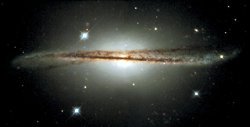Young Galaxies Too Old for the Big Bang
Originally published in Creation 26, no 3 (June 2004).
This discovery is a huge problem for evolutionary timescales. These galaxies exist when, according to big bang cosmology, they shouldn’t have had time to form.
A team of astronomers from the University of Texas announced a startling discovery this year [2004]. They had used the 4-metre Blanco Telescope in Chile to find a long string of fully formed galaxies.1 It has sometimes been called the Francis Filament, after team member Dr Paul Francis from the Australian National University.
The astronomers calculated that the supercluster was 300 million light-years across, and right at the most distant edge of the universe, 10.8 billion light-years away. (A light-year is how far light would travel at its current speed of 300,000 km/s (186,000 mps) in a year—9.5 trillion km or 5.9 trillion miles.)
These galaxies exist when, according to big bang cosmology, they shouldn't have had time to form.
However, the discovery is a huge problem for evolutionary timescales. These galaxies exist when, according to big bang cosmology, they shouldn't have had time to form.
The astronomers used a filter to block out light from other sources. This enabled them to pick out galaxies so far from Earth. They expected to find young, faint “proto”-galaxies spread evenly throughout the area. Instead, they found 37 mature, bright galaxies that seem to be lined up in a string, with emptiness elsewhere. It was exactly the opposite of what they expected from the big bang theory. Further observations from Siding Springs Observatory in Australia confirmed this galaxy cluster was real.
The galaxy cluster lies in the direction of the southern hemisphere constellation Grus (the Crane). At such a distance, evolutionary astronomers assume they are viewing the galaxies as they were around 11 billion years ago. This is allegedly just two billion years after the big bang supposedly formed the universe.

The research team caused a stir when they reported their discovery at a meeting of the American Astronomical Society on 7 January this year. Astronomers around the world were astonished at how mature galaxies could have formed so fast in the young universe.2
In the current main evolutionary model, galaxies formed from variations in the density of matter produced by the big bang. Big bangers imagine that the universe needed billions of years before stars and galaxies could form into the recognizable structures we see near the Milky Way galaxy today. But this new discovery is precisely the reverse of big-bang predictions:
- These galaxies appear to be fully formed, mature structures.
- The galaxies are aligned in a long string.
- The string is colossal—more than 300 million light-years long.
Dr Francis himself expressed the problem, “The simulations tell us that you cannot take the matter in the early universe and line it up in strings this large”, he said. “There simply hasn”t been enough time since the big bang to form structures this colossal.”
Naturalistic cosmologists will undoubtedly find a way to fit this new evidence into the atheistic big bang model. However, this would merely show that scientists always interpret facts in the light of theory. Theory, in turn, depends on one”s belief system. The big bang theory is based on naturalism—the belief system that discounts God”s recent supernatural acts to create the universe.
The existence of such large, mature galaxies lined up in a beautiful filament makes more sense when interpreted within the biblical belief system. That is, God rapidly and supernaturally created fully-formed stars and galaxies on Day 4 of Creation Week. “By the word of the Lord were the heavens made” (Psalm 33:6).3
Footnotes
- Other details sourced from University of Texas/McDonald Observatory Press Release, 12 January 2004.
- Why galaxy cluster is too grown-up for early universe, New Scientist 181(2430):14, 17 January 2004.
- See also Hartnett, J., Francis Filament: a large scale structure that is big, big, big bang trouble. Is it really so large? TJ 18(1):16–17, 2004.
Recommended Resources

Answers in Genesis is an apologetics ministry, dedicated to helping Christians defend their faith and proclaim the good news of Jesus Christ.
- Customer Service 800.778.3390
- Available Monday–Friday | 9 AM–5 PM ET
- © 2025 Answers in Genesis


